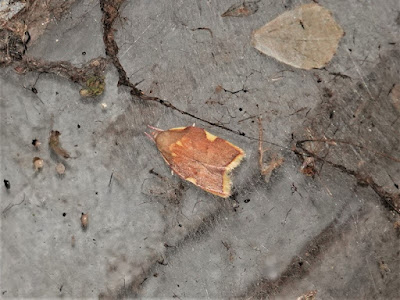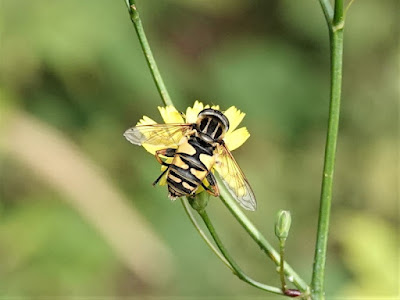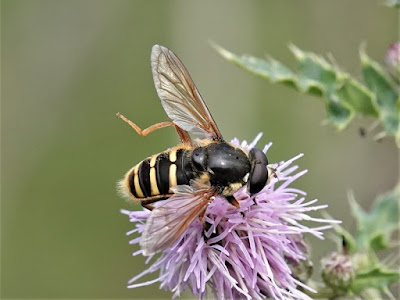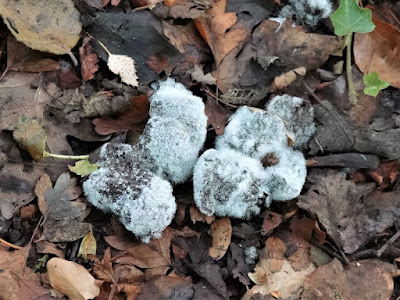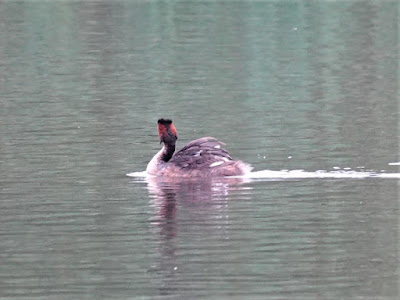14.0°C > 17.0°C: Mostly cloudy with a few brighter spells. Moderate north-westerly breeze. Moderate visibility and hazy.
Sunrise: 05:16 BST
* = a species photographed today
$ = my first sighting of the species for this year
$$ = my first ever recorded sighting of the species in the area
Priorslee Balancing Lake: 05:00 – 06:30 // 07:45 – 10:00
(179th visit of the year)
Bird notes:
- again some Canada Geese when I arrived flew off before I had any visibility of the water. Eventually 67.
- a single Greylag Goose throughout.
- a group of four reasonably well-grown Mallard ducklings. This is confusing: they seemed too large to be remnant from the recent group of seven but I have not seen any candidate broods recently.
- the duck Pochard – I assume the same one – reappeared.
- just five juvenile Great Crested Grebes found. The one from the oldest brood is now independent and likely as an elusive submarine and are many of the adults. Only one of the brood of two keeping close to one parent. Perhaps the other was with the other parent somewhere?
- a Common Kestrel flew East overhead 06:00
- a Blackbird was heard singing again.
- a Cetti's Warbler was calling along the North side. Throughout the breeding season all song and calls have been from the West or the South. During last winter the birds were frequently along the North but not since.
Bird(s) noted flying over here:
- 3 Feral Pigeons: together
- 103 Wood Pigeons
- 1 Herring Gull
- 6 Lesser Black-baked Gulls again
- 1 Common Kestrel
- 27 Jackdaws
- 12 Rooks
Counts from the lake area:
- 67 Canada Geese: see notes
- 1 Greylag Goose: see notes
- 2 Mute Swans
- 23 (?♂) + 4 (1 brood) Mallard: see notes
- 10 + 1 (dependent brood) Moorhens
- 103 Coots
- ? + 5 (3 broods) Great Crested Grebes: see notes
- 12 Black-headed Gulls again: no juveniles
- 4 Lesser Black-baked Gulls
- 1 Grey Heron
Hirundines etc. noted:
- 1 House Martin.
Warblers recorded (the figure in brackets is birds noted singing):
- 1 (0) Cetti's Warblers
- 8 (1) Chiffchaffs
- 2 (0) Reed Warblers
- 5 (1) Blackcaps
Noted on the West end street lamp poles around-dawn:
Moths: [presented in biological sequence order; species number is my sighting sequence]
*1 $ Oak Longhorn Carcina quercana [was Long-horned Flat-body] [species #73]
2 White Plume Pterophorus pentadactyla [species #71]
*1 Dun-bar Cosmia trapezina [species #72]
*1 $ Oak Longhorn Carcina quercana [was Long-horned Flat-body] [species #73]
2 White Plume Pterophorus pentadactyla [species #71]
*1 Dun-bar Cosmia trapezina [species #72]
Bees, wasps etc.:
1 Common Wasp Paravespula vulgaris
1 Common Wasp Paravespula vulgaris
Flies:
1 plumed midge Chironomus plumosus
1 plumed midge Chironomus plumosus
Spiders, harvestmen etc.:
2 Bridge Orb-web Spiders Larinioides sclopetarius
2 Long-jawed Orb-web Spiders Tetragnatha sp.
1 harvestman Leiobunum blackwalli
Noted later:
More despite the cloudy conditions.
2 Bridge Orb-web Spiders Larinioides sclopetarius
2 Long-jawed Orb-web Spiders Tetragnatha sp.
1 harvestman Leiobunum blackwalli
Noted later:
More despite the cloudy conditions.
Butterflies:
Large White Pieris brassicae
Green-veined White Pieris napi
*Speckled Wood Pararge aegeria
Gatekeeper Pyronia tithonus
Common Blue Polyommatus icarus
Large White Pieris brassicae
Green-veined White Pieris napi
*Speckled Wood Pararge aegeria
Gatekeeper Pyronia tithonus
Common Blue Polyommatus icarus
Moths
4 Straw Grass-moths Agriphila straminella [was Straw Grass-veneer]
>10 unidentified grass moths, possibly all the same species
*1 Meadow Hook-wing Ancylis badiana [was Common Roller]
*1 $ Mint Moth Pyrausta aurata [was Small Purple & Gold] [species #74]
1 Pale Straw Pearl Udea lutealis
*1 caterpillar of a Vapourer Orgyia antiqua : my fourth this year all on the "boxing ring"
4 Straw Grass-moths Agriphila straminella [was Straw Grass-veneer]
>10 unidentified grass moths, possibly all the same species
*1 Meadow Hook-wing Ancylis badiana [was Common Roller]
*1 $ Mint Moth Pyrausta aurata [was Small Purple & Gold] [species #74]
1 Pale Straw Pearl Udea lutealis
*1 caterpillar of a Vapourer Orgyia antiqua : my fourth this year all on the "boxing ring"
Bees, wasps etc.:
*Common Carder Bee Bombus pascuorum
Buff-tailed Bumblebee Bombus terrestris
Common Wasp Paravespula vulgaris
unidentified small ichneumon
Turnip Sawfly Athalia rosae
*Common Carder Bee Bombus pascuorum
Buff-tailed Bumblebee Bombus terrestris
Common Wasp Paravespula vulgaris
unidentified small ichneumon
Turnip Sawfly Athalia rosae
Hoverflies:
Marmalade Hoverfly Episyrphus balteatus
Tapered Dronefly Eristalis pertinax
*Meadow Field Syrph Eupeodes latifasciatus [Broad-banded Aphideater]
*Common Spotted Field Syrph Eupeodes luniger [Lunuled Aphideater]
*Tiger Hoverfly Helophilus pendulus [Tiger Marsh Fly; Sun Fly]
Chequered Hoverfly Melanostoma scalare [Long-winged Duskyface]
*$$ Yellow-barred Peat Hoverfly Sericomyia silentis [Yellow-barred Pond Fly]
*$$ Interrupted Globetail Sphaerophoria interrupta
*Common Twist-tail Sphaerophoria scripta [Long Hoverfly; Common Globetail]
*$$ Broad-banded Globetail Sphaerophoria taeniata
Marmalade Hoverfly Episyrphus balteatus
Tapered Dronefly Eristalis pertinax
*Meadow Field Syrph Eupeodes latifasciatus [Broad-banded Aphideater]
*Common Spotted Field Syrph Eupeodes luniger [Lunuled Aphideater]
*Tiger Hoverfly Helophilus pendulus [Tiger Marsh Fly; Sun Fly]
Chequered Hoverfly Melanostoma scalare [Long-winged Duskyface]
*$$ Yellow-barred Peat Hoverfly Sericomyia silentis [Yellow-barred Pond Fly]
*$$ Interrupted Globetail Sphaerophoria interrupta
*Common Twist-tail Sphaerophoria scripta [Long Hoverfly; Common Globetail]
*$$ Broad-banded Globetail Sphaerophoria taeniata
Dragon-/Damsel-flies:
Common Blue Damselfly Enallagma cyathigerum [Common Bluet]
Common Blue Damselfly Enallagma cyathigerum [Common Bluet]
Caddis etc. flies:
none
none
Other flies:
*$ Thick-headed Fly Conops quadrifasciatus [Four-banded Beegrabber]
dagger fly Empis livida
*$ probable Muscid fly Eudasyphora cyanella
*Awkward Clusterfly Pollenia rudis
otherwise only unidentified fly species
*$ Thick-headed Fly Conops quadrifasciatus [Four-banded Beegrabber]
dagger fly Empis livida
*$ probable Muscid fly Eudasyphora cyanella
*Awkward Clusterfly Pollenia rudis
otherwise only unidentified fly species
Bugs etc.:
*mirid bug Plagiognathus arbustorum
*mirid bug Plagiognathus arbustorum
Beetles:
7 Spot Ladybird Coccinella 7-punctata
Common Red Soldier Beetle Rhagonycha fulva
7 Spot Ladybird Coccinella 7-punctata
Common Red Soldier Beetle Rhagonycha fulva
Amphibians:
none
none
Spiders, harvestmen etc.:
*Garden Spider Araneus diadematus [Garden Cross Spider]
*$ White Crab Spider Misumena vatia [Flower Spider]
*Garden Spider Araneus diadematus [Garden Cross Spider]
*$ White Crab Spider Misumena vatia [Flower Spider]
Fungus:
*unidentified fungus
*unidentified fungus
New flowers for the year:
None
Tucked up at the very top of a street lamp pole I noted this Oak Longhorn Carcina quercana. Another species renamed and formerly known as a Long-horned Flat-body
Not my best shot: a Meadow Hook-wing moth Ancylis badiana . This species used to be known as Common Roller because it is common and the larvae spin a web in which to pupate, rolling-up a leaf in the process.
A splendid little moth: a Mint Moth Pyrausta aurata feeding on Water Mint Mentha aquatica. The old name for this was Small Purple & Gold but in size it is almost indistinguishable from Common Purple & Gold P. purpuralis.
Also tucked up under the same street lamp as the Oak Longhorn was my first Dun-bar Cosmia trapezina here (I noted one at The Flash on Monday]
Close up with a Tapered Dronefly Eristalis pertinax. Despite being a male and the abdomen not appearing especially tapered the pale areas on the front legs mean it must be this species. Common Dronefly E. tenax has all-dark legs (and has been unusually scarce this year).
The medium-sized yellow and black hoverflies are not easy to separate. This is a Meadow Field Syrph Eupeodes latifasciatus. The Obsidentify name of Broad-banded Aphideater provides a clue.
This Common Spotted Field Syrph E. luniger can be separated by the shape of the yellow marks as lunules and hence the alternative name of Lunuled Aphideater.
I concluded this had to be just a regular Tiger Hoverfly Helophilus pendulus at an unusual angle. It looks wider-bodied than most; the lines on the thorax look narrower; and the bottom yellow, divided band on the abdomen looks unusually wide and parallel. Unless it is a species new to science....
The first of no fewer than three new species of hoverfly for me this morning. This is a Yellow-barred Peat Hoverfly Sericomyia silentis which Obsidentify calls Yellow-barred Pond Fly.
The view of its abdomen showing the narrow, straight and divided bars. Primarily a species of boggy areas of the North and West of the UK Steven Falk's narrative notes that it is a mobile species that not infrequently turns in woodland rides and meadows far from any obvious breeding site.
Here is the second: an Interrupted Globetail Sphaerophoria interrupta with the usual yellow bars of this group divided. I noted at least two of these.
A reminder: this is what the usual Common Twist-tail S. scripta or Long Hoverfly; Common Globetail looks like.
And this confused me somewhat. It looks somewhat like another Common Twist-tail but the yellow bars seem to angle down at the edge of the abdomen. I have concluded that it looks unusual because I do not often view this species from the side.
This may look like another hoverfly but in reality is is a Thick-headed Fly Conops quadrifasciatus also known as a Four-banded Beegrabber.
The spider and the fly. What I believe to be a Garden Spider Araneus diadematus wrapped up its prey neatly in the time it took the camera to decide to focus on the action.
A White Crab Spider Misumena vatia or Flower Spider. This spider hides in flowers and waits for prey to blunder past. It is reported that they can change colour to match their surrounding. I have only ever seen white ones so perhaps the camouflage of the others is good.
I do not know what to make of this. I thought it was a fungus but it was not attached to the soil and the texture was more like coral. Both Obsidentify and Google Lens named different possible species of fungus but neither checked out with photos on NatureSpot.
(Ed Wilson)
In the Priorslee Avenue tunnel:
(175th visit of the year)
Bird notes:
- no Mallard duckling noted.
- now the other pair of Great Crested Grebes have young. Still riding on the parent's back so I am unsure how many. Three juveniles remain with the first pair to produce.
- a tight group of 16 House Martins suddenly appeared overhead and moments later and just as suddenly disappeared. Surely not departing migrants already?
- a Marsh Tit was calling alongside the Wesley Brook as I walked up from the Balancing Lake.
Bird(s) noted flying over here:
- 1 Jackdaw
Noted on / around the water:
- 35 Canada Geese
- 13 Greylag Geese
- 6 Mute Swans
- *24 (?♂) Mallard
- 21 (?♂) Tufted Duck
- 6 Moorhens again
- 78 + 8 (4 dependent broods) Coots
- *4 + >3 (2 broods) Great Crested Grebes
- 2 Black-headed Gulls: adults again
- no Grey Heron
Hirundines etc. noted:
- 16 House Martins: see notes
Warblers recorded (the figure in brackets is birds noted singing):
- 3 (0) Chiffchaffs again
- 1 (0) Blackcap only
Noted around the area:
It makes a change to find a pristine-looking Speckled Wood butterfly Pararge aegeria.
This is inexplicable. Here is the fourth caterpillar of a Vapourer moth Orgyia antiqua I have found on the "boxing ring". The first was on 20 May and they have all been several weeks apart. I have not seen any elsewhere nor I have I seen any adults.
How could I resist this delightful Common Carder Bee Bombus pascuorum?
I also did not realise that the hind femur of this species was so enlarged.
The first of no fewer than three new species of hoverfly for me this morning. This is a Yellow-barred Peat Hoverfly Sericomyia silentis which Obsidentify calls Yellow-barred Pond Fly.
And the third: the well-named Broad-banded Globetail S. taeniata.
I think this is probably the Muscid fly Eudasyphora cyanella
An "easy" fly with the golden-haired thorax. It is an Awkward Clusterfly Pollenia rudis.
I seem to be able attract bugs on to my hands: a mirid bug Plagiognathus arbustorum.
(Ed Wilson)
------------------------------------------------------------------------------------------------------
In the Priorslee Avenue tunnel:
Moths: [30 species here before today; one addition]
1 Brown House-moth Hofmannophila pseudospretella
*1 Common Masoner Blastobasis adustella [was Dingy Dowd] [species #31 here]
3 Single-dotted Waves Idaea dimidiata
1 Brown House-moth Hofmannophila pseudospretella
*1 Common Masoner Blastobasis adustella [was Dingy Dowd] [species #31 here]
3 Single-dotted Waves Idaea dimidiata
Flies:
5 moth flies Psychodidae sp. [Drain Fly or Owl Fly]
20 midges of various species.
5 moth flies Psychodidae sp. [Drain Fly or Owl Fly]
20 midges of various species.
Arthropods:
1 White-legged Snake Millipede Tachypodoiulus niger
1 White-legged Snake Millipede Tachypodoiulus niger
Spiders, harvestmen etc.:
2 Missing Sector Orb-web Spider Zygiella x-notata [Silver-sided Sector Spider]
2 Missing Sector Orb-web Spider Zygiella x-notata [Silver-sided Sector Spider]
This moth on the ceiling is a Common Masoner Blastobasis adustella. It used to known as Dingy Dowd. I am not sure the new name is better. It comes in two forms: the dark form here and a pale form with a black inverted 'V' mark across the folded wing. I check for moths, with a torch, both the ceiling and the accessible wall as I walk each way between the lake and The Flash. I am surprised how often I notice a moth as I am waking back that I did not notice walking the other way. This was one such sighting. Do they fly in? Or am I not very observant?
(Ed Wilson)
The Flash: 06:35 – 07:40
(Ed Wilson)
------------------------------------------------------------------------------------------------------
The Flash: 06:35 – 07:40
(175th visit of the year)
Bird notes:
- no Mallard duckling noted.
- now the other pair of Great Crested Grebes have young. Still riding on the parent's back so I am unsure how many. Three juveniles remain with the first pair to produce.
- a tight group of 16 House Martins suddenly appeared overhead and moments later and just as suddenly disappeared. Surely not departing migrants already?
- a Marsh Tit was calling alongside the Wesley Brook as I walked up from the Balancing Lake.
Bird(s) noted flying over here:
- 1 Jackdaw
Noted on / around the water:
- 35 Canada Geese
- 13 Greylag Geese
- 6 Mute Swans
- *24 (?♂) Mallard
- 21 (?♂) Tufted Duck
- 6 Moorhens again
- 78 + 8 (4 dependent broods) Coots
- *4 + >3 (2 broods) Great Crested Grebes
- 2 Black-headed Gulls: adults again
- no Grey Heron
Hirundines etc. noted:
- 16 House Martins: see notes
Warblers recorded (the figure in brackets is birds noted singing):
- 3 (0) Chiffchaffs again
- 1 (0) Blackcap only
Noted around the area:
Butterflies:
none
none
Moths [on street lamp poles and in the grass] [60 species here before today: no additions]
1 Straw Grass-moth Agriphila straminella [was Straw Grass-veneer]
*1 Small Fan-footed Wave Idaea biselata
*1 Riband Wave Idaea aversata
1 Swallow Prominent Pheosia tremula
1 Straw Grass-moth Agriphila straminella [was Straw Grass-veneer]
*1 Small Fan-footed Wave Idaea biselata
*1 Riband Wave Idaea aversata
1 Swallow Prominent Pheosia tremula
Bees, wasps etc.:
Common Carder Bee Bombus pascuorum
Buff-tailed Bumblebee Bombus terrestris
Common Wasp Paravespula vulgaris
Common Carder Bee Bombus pascuorum
Buff-tailed Bumblebee Bombus terrestris
Common Wasp Paravespula vulgaris
Hoverflies:
Marmalade Hoverfly Episyrphus balteatus
Chequered Hoverfly Melanostoma scalare [Long-winged Duskyface]
Marmalade Hoverfly Episyrphus balteatus
Chequered Hoverfly Melanostoma scalare [Long-winged Duskyface]
Dragon-/Damsel-flies:
none
none
Caddis etc. flies:
none
none
Other flies:
1 female plumed midge Chironomus plumosus
otherwise only unidentified fly species
1 female plumed midge Chironomus plumosus
otherwise only unidentified fly species
Bugs etc.:
Red-legged Shieldbug Pentatoma rufipes
mirid bug Plagiognathus arbustorum
Red-legged Shieldbug Pentatoma rufipes
mirid bug Plagiognathus arbustorum
Beetles:
7 Spot Ladybird Coccinella 7-punctata
Common Red Soldier Beetle Rhagonycha fulva
7 Spot Ladybird Coccinella 7-punctata
Common Red Soldier Beetle Rhagonycha fulva
Spiders, harvestmen etc.:
5 harvestmen Dicranopalpus ramosus/caudatus
5 harvestmen Dicranopalpus ramosus/caudatus
Fungus
*possible Blushing Milkcap Lactarius controversus [Lactifluus controversus in Obsidentify]
*possible Blushing Milkcap Lactarius controversus [Lactifluus controversus in Obsidentify]
New flowers for the year:
None
No juveniles visible but the way the Great Crested Grebe is holding its feather arched over its back is a very good indication that youngsters are sheltering there.
I noted yesterday the number of moths I find resting on vegetation under the (extinguished) street lights alongside the Wesley Brook. Here is another such: a Small Fan-footed Wave Idaea biselata.
And yet another resting on vegetation beneath a different street light was this Riband Wave Idaea aversata of the form remutata without the filled-in cross-band.
A fungus I note every year in the wooded area at the top end. It is possibly Blushing Milkcap Lactarius controversus [Lactifluus controversus in Obsidentify for some reason]. I did some "gardening": any more and I would have damaged the fungus.
(Ed Wilson)
No juveniles visible but the way the Great Crested Grebe is holding its feather arched over its back is a very good indication that youngsters are sheltering there.
A drake Mallard showing signs of moulting in to its breeding plumage.
(Ed Wilson)

